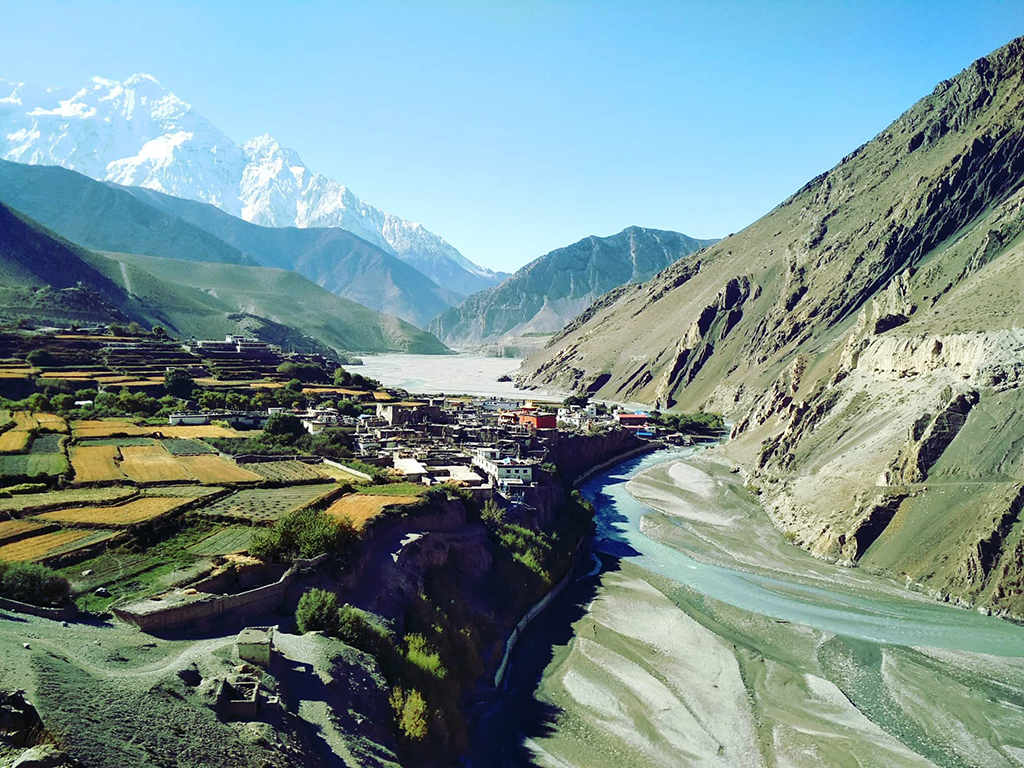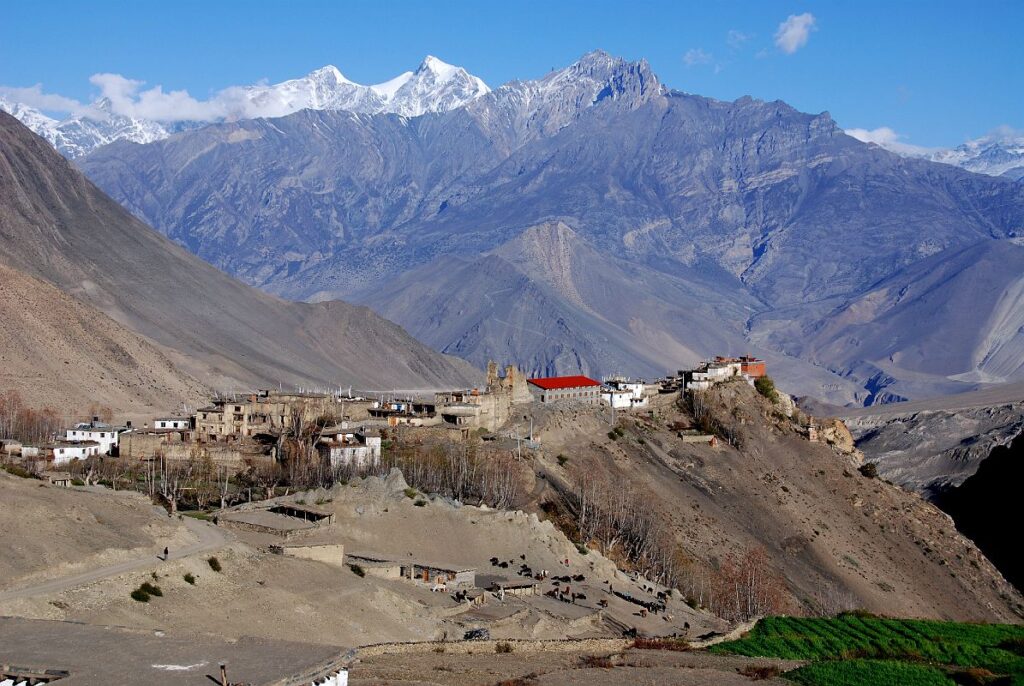Lower Mustang Trek
- Home
- Lower Mustang Trek

The Lower Mustang Trek is one of Nepal’s most culturally rich and naturally diverse journeys, offering trekkers a rare opportunity to explore the trans-Himalayan landscapes, centuries-old Buddhist monasteries, and traditional Tibetan-influenced communities. Located along the ancient salt trade route between Nepal and Tibet, Lower Mustang provides an immersive Himalayan experience without requiring extreme altitude or challenging climbs, making it suitable for beginners, families, and cultural travelers.
This region is part of the Annapurna Conservation Area, featuring arid desert cliffs, windswept valleys, sacred pilgrimage sites, and pristine views of the Nilgiri, Dhaulagiri, and Annapurna ranges. With its mild elevation, stable weather, and deep cultural heritage, the Lower Mustang Trek stands out as one of the most accessible yet rewarding trekking routes in Nepal.

Meet at Tribhuvan International Airport and transfer to your hotel. Pre-trek briefing in the evening.
A scenic countryside journey along the Trishuli River leads to the lake city of Pokhara.
Drive through the world’s deepest gorge, Kali Gandaki, toward Jomsom.
Optional: Take a short 20-minute flight for quicker travel.
Start your trek through the desert-like valley to Kagbeni, a charming medieval settlement.
Walk through traditional Mustang villages and visit the historic Red Gompa—known for its ancient murals and Buddhist relics.
Gradually ascend to Muktinath, the sacred pilgrimage site with Hindu and Buddhist shrines, natural springs, and panoramic mountain views.
Descend along a scenic route back to Jomsom, known for its apple orchards and strong Mustang winds.
Return to Pokhara via mountain roads.
Optional: Fly back for comfort and time efficiency.
A scenic return journey to Kathmandu. Farewell dinner in the evening.
Transfer to the airport for your international flight.
The Lower Mustang Trek is one of the few trekking routes in Nepal that can be enjoyed almost year-round, thanks to its location in the rain-shadow region of the Annapurna and Dhaulagiri ranges. This unique geographical position keeps the area dry even during the monsoon season, making the climate far more stable than many other Himalayan regions. However, certain seasons offer the best combination of clear skies, comfortable temperatures, and vibrant cultural experiences.
Spring is widely considered the best time to trek in Lower Mustang. The weather is mild, days are longer, and the visibility is excellent.
Autumn brings the clearest skies of the year and is one of the most reliable seasons for trekking in Nepal.
Unlike most trekking regions in Nepal, Lower Mustang is protected by the Himalayas and sits in a dry, desert-like rain shadow.
Note: While the region is dry, flights to Jomsom may face delays due to cloud cover around Pokhara.
Winter is suitable for trekkers seeking solitude and crisp mountain views, but temperatures can get quite low, especially in Muktinath.
Considerations
| Season | Weather | Visibility | Trail Conditions | Crowd Level |
|---|---|---|---|---|
| Spring | Mild & stable | Excellent | Dry & comfortable | Moderate/High |
| Autumn | Clear & cool | Best | Ideal | High |
| Monsoon | Dry rain-shadow | Good | Mostly stable | Low |
| Winter | Cold but clear | Excellent | Manageable | Very Low |
The best time for the Lower Mustang Trek is Spring (March–May) and Autumn (September–November) for the best balance of comfort, visibility, and cultural richness.
However, thanks to its rain-shadow climate, Lower Mustang remains one of Nepal’s top year-round trekking destinations, with each season offering a unique experience.
The Lower Mustang Trek is considered one of Nepal’s easy to moderate trekking routes, making it suitable for beginners, families, senior travelers, and anyone seeking a culturally immersive Himalayan journey without the challenges of high-altitude expeditions. The trek offers stunning landscapes, ancient monasteries, and rewarding Himalayan views while keeping the physical demands manageable.

Lower Mustang is easier compared to popular high-altitude treks like Everest Base Camp, Annapurna Circuit, and Manaslu. The trekking days are relatively short, the trails are well-marked, and the maximum altitude is 3,710 meters at Muktinath—an elevation that poses minimal risk of altitude sickness for most trekkers with proper pacing.
Trekkers typically walk 5–6 hours per day, which is comfortable for most fitness levels. The terrain varies from flat riverbeds to gentle ascents, with no technical sections.
The highest point is Muktinath at 3,710m, which is safe for gradual acclimatization.
Most trekkers experience:
Serious altitude-related issues are rare on this route.
Lower Mustang is part of the Annapurna region—one of Nepal’s most organized trekking areas. The paths are clear, safe, and frequently used by local villagers, horses, and trekkers.
You will stay in teahouses that offer warm dining areas, hearty meals, and good hospitality. Villages are spaced conveniently, allowing trekkers to rest often and walk at a comfortable pace.
This trek does not require:
A reasonable level of fitness is more than enough.
Even though Lower Mustang is easier than many other treks, trekkers should be aware of:
The Kali Gandaki Valley is known for afternoon winds. Morning starts help avoid discomfort.
Wearing a buff or mask helps protect from dust during windy sections.
Sections like the climb from Jharkot to Muktinath can be tiring but manageable with slow pacing.
Temperatures drop quickly, particularly from November to February.
Anyone with basic walking fitness can comfortably complete this trek.
The Lower Mustang Trek is one of Nepal’s most approachable and beginner-friendly treks, offering a perfect blend of culture, mountain scenery, and spiritual heritage without demanding physical challenges. With proper preparation and guided support, trekkers of all ages and fitness levels can complete this journey comfortably and safely.
A: The Lower Mustang Trek is an easy to moderate trek, suitable for beginners, families, and senior travelers. Daily walking hours range from 4–6 hours on well-established trails. The maximum elevation is 3,710m at Muktinath, which poses minimal altitude risk for most trekkers.
A: The standard itinerary takes 10 days, including arrival and departure days.
The core trekking portion usually lasts 5–6 days, depending on the route and pacing.
A: The best seasons are:
However, Lower Mustang lies in a rain-shadow region, making it suitable for monsoon trekking (June–August) as well. Winter offers solitude and clear skies but colder temperatures.
A: No special restricted-area permit is required. You only need:
These are included in most trekking packages.
A: The highest point on the Lower Mustang Trek is Muktinath Temple at 3,710 meters.
A: Altitude sickness risk is very low on this trek due to the moderate elevation and gradual ascent. Staying hydrated and walking at a comfortable pace minimizes any discomfort.
A: You will stay in teahouses during the trek.
These offer:
In Kathmandu and Pokhara, accommodation is usually 3-star hotels unless upgraded.
A: Teahouses offer a variety of meals, including:
All meals during trekking are included in the package.
A: Absolutely. This trek is ideal for first-time trekkers due to its moderate difficulty and lower altitude. Basic fitness is helpful but no technical skills are required.
A: There are two options:
Driving is more affordable, while flying saves time and offers scenic views.
A: Flights can sometimes be affected by weather in Pokhara, especially during winter or monsoon months. Having a buffer day is recommended if choosing to fly.
A: Important items include:
Sleeping bag and down jacket are usually provided by Nepal Treks and Tour.
A: Wi-Fi is available in some teahouses, especially in Jomsom, Kagbeni, and Muktinath. Connectivity may be limited in remote areas.
A: Yes. Most teahouses offer charging for a small extra fee. Carrying a power bank is recommended.
A: Yes, Lower Mustang is considered very safe, with friendly locals and well-established trekking infrastructure. Traveling with a guide enhances safety and cultural experience.
A: Lower Mustang offers:
It’s a perfect blend of culture, spirituality, and scenery.
A: A licensed, English-speaking, experienced trekking guide will lead your journey. They are trained in first aid, altitude awareness, local culture, and responsible trekking practices.
A: Yes. In Mustang’s Buddhist and Hindu communities:
A: Travel insurance is highly recommended, covering:
A: If you can comfortably walk for 4–6 hours per day, you are fit enough for this trek. Some light training before the trip—walking, hiking, or stair climbing—is beneficial.
Most itineraries range from 7 to 10 days, depending on starting points (Jomsom or Kagbeni) and acclimatization days.
Difficulty Level: Easy to Moderate
The trails are well-marked, and altitude gains are gradual. Suitable for beginners, families, and cultural travelers.
Muktinath Temple: 3,800 meters (12,467 ft)
This altitude is relatively manageable, though mild AMS symptoms can occur.
To trek in Lower Mustang, you need:
Cost:
USD 30 for foreign trekkers
NPR 100 for SAARC nationals
Cost:
USD 20 for independent trekkers
USD 10 for group trekkers
Restricted Area Permit is NOT required for Lower Mustang. It is only required for Upper Mustang.
Meals: Dal Bhat, noodles, soups, momo, Tibetan bread, Thukpa
Water:
Mineral water available
Filtered or boiled water recommended for sustainability
Most treks start with:
Drive or flight from Pokhara to Jomsom
Though the maximum elevation is moderate, trekkers should be aware of:
Hydration, gradual ascent, and rest days help prevent AMS.
Our local guide enhances safety and supports the regional economy.
Lower Mustang is deeply influenced by Tibetan Buddhism.
Recommended to cover:
PRICE INCLUDE |
|
|---|---|
PRICE EXCLUDE |
|
Write Your Review